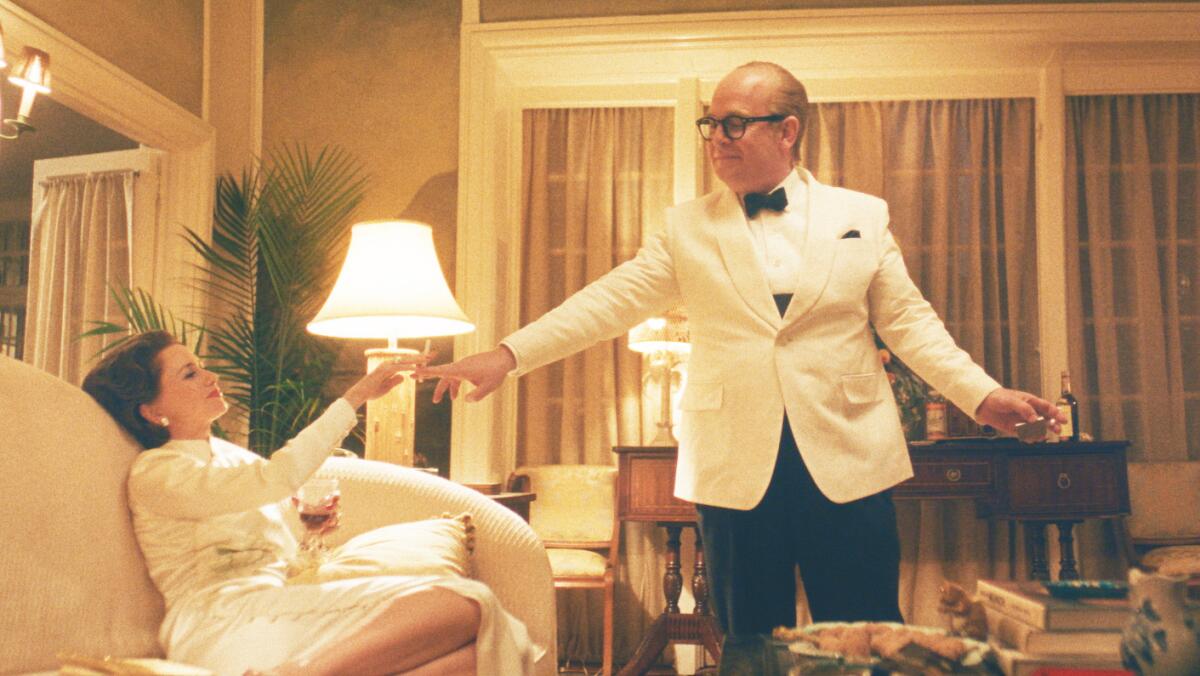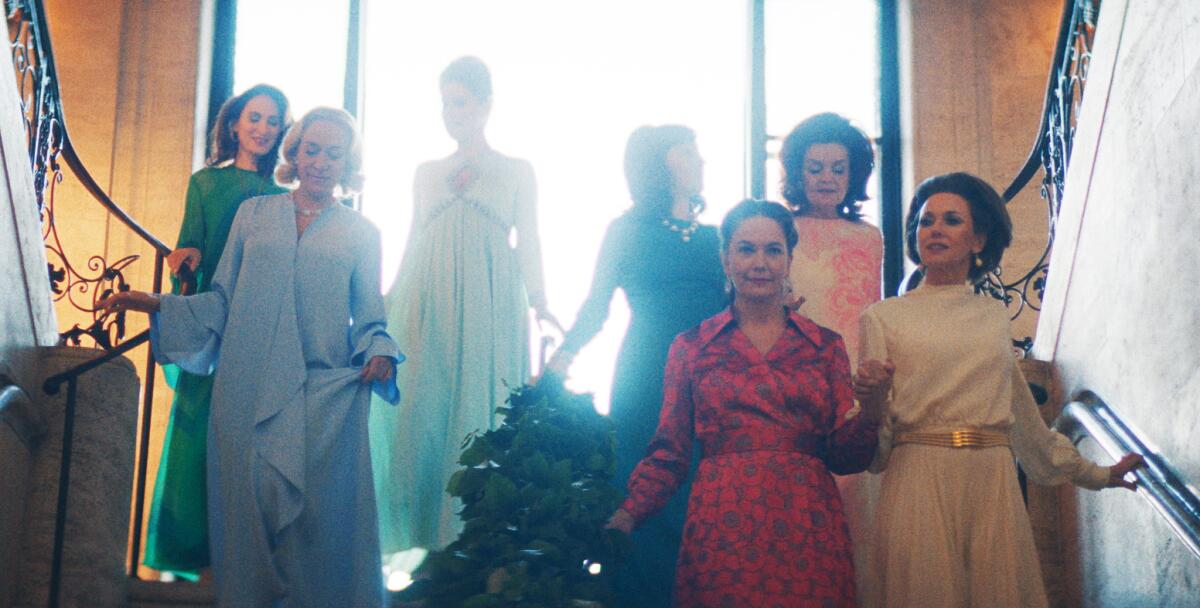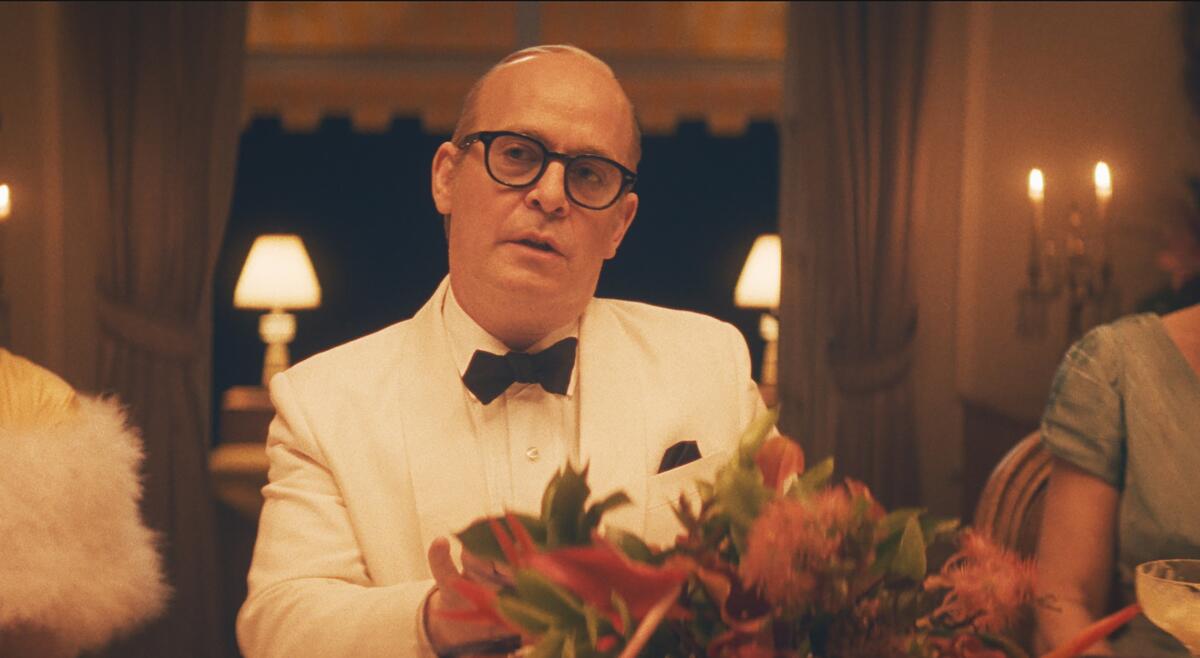A glamorous squad and gossip fuel Ryan Murphy’s ‘Feud: Capote vs. the Swans’

- Share via
“Capote vs. the Swans,” which premieres Wednesday on FX, forms the second season of anthology king Ryan Murphy’s “Feud,” following at a distance 2017’s “Bette and Joan,” as in Davis and Crawford. Written by Jon Robin Baitz and directed by Gus Van Sant, it concerns the writer Truman Capote, not so much played as inhabited by Tom Hollander, and the high-society women he called his “swans.” It is historically and thematically thorough, intelligently written, inevitably speculative, beautifully played, handsomely mounted, occasionally a little ridiculous and probably too long. And as a story about the perils of gossip that itself repeats gossip, and as the story of a writer who sometimes played with facts in the service of his writing that plays with facts in the service of the drama, inescapably ironic. But that’s entertainment.
Apart from an ongoing fascination with midcentury high society, at which fashion magazines will irregularly cast a backward look, and with the publicly voluble enigma that was Capote, the series’ billboard attraction is its cast of actresses, some of whom became famous young and now may be called “of a certain age”: Naomi Watts, Diane Lane, Chloë Sevigny, Molly Ringwald, Calista Flockhart and Demi Moore. (Even Sevigny, a ’90s teenage underground It girl, is 49 now.) Well, time is a subject here.
The trigger of the eponymous feud is the November 1975 publication in Esquire magazine of “La Côte Basque, 1965,” a chapter of Capote’s very unfinished, way-past-deadline “Answered Prayers,” the social novel he predicted would be a “masterpiece” and liked to liken to Proust’s “Remembrance of Things Past.” The piece, which included thinly veiled portrayals of a couple of swans and others who were easy to identify, was a betrayal of trust whose negative reception Capote seems to have regarded with surprise — they knew he was a writer, he protested, and that he was writing this book. But he was cast out from the New York high society in which he’d been comfortably ensconced as a reliably amusing character, companion and dinner guest for a couple of decades.

Watts plays Babe Paley, often described as the most beautiful, perfectly turned out woman of her time, and, up until “La Côte Basque,” which exposed unhappy aspects of her marriage to CBS honcho William S. Paley, Truman’s soulmate; beneath all the various biographical bullet points and side plots, the series is essentially a broken love story between the two. (Babe also has cancer, which will lend her increasing depth, as it dramatically must.) Lane plays Slim Keith, who, in the person of Lady Coolbirth, does most of the talking in “La Côte Basque,” and who will subsequently lead the anti-Truman brigade (“Nothing in nature pretends to love you and then tries to eat you.”). And as C.Z. Guest, the most reasonable swan, and the only woman pictured with actual interests — she gardens, she rides — Sevigny brings light to what can be a dark show, myriad witticisms notwithstanding.
Flockhart is Lee Radziwill, the swan with the least distinct profile, appropriate to her position as Jacqueline Kennedy Onassis’ less fabulous sister. Moore plays Ann Woodward, a possible murderess whose story Capote tells here at a dinner table early in the first episode and which makes up a sizable chunk of “La Côte Basque.” (And which may have led to a suicide.) And Ringwald is Joanne Carson, Johnny’s ex-wife, who in later years provided Capote a place to stay and work in California, though in this telling she is mostly a hook on which to hang jokes about West Coast pursuits — meditation, rolfing, colonics — and taste. “She buys paper lamps from Pier One,” Truman complains.
And there is Capote’s dead mother, played by Murphy stock player Jessica Lange, trailing clouds of Gothic melodrama otherwise absent from the series. It will be bruited here, as it is in this world, that Capote can be explained in large part in by his relationship to his mother, who herself dreamed of New York social status, and abandoned her son in its pursuit.
Read on its own, without context, there is not much to “La Côte Basque, 1965,” certainly nothing to suggest that it would be the foundation of any sort of “masterpiece.” It is literally just gossip, lightly framed (in some admittedly lambent prose), set off by quotation marks and with some but not all names changed. (Carol Matthau and Gloria Vanderbilt appear as characters, telling tales of Cole Porter and J.D. Salinger.) That it may be true to what Capote heard first- or secondhand — he claimed to have a near verbatim recall for conversation — speaks even less to its quality as literature. Depending on the situation or his mood, he would characterize it as fiction or nonfiction or something in between.

Baitz finds ways to keep the “Feud” theme alive through Capote’s years of exile and alcohol- and pharmaceutical-fueled decline by having the parties talk about each other, if not to one another. (Amid the sniping, there is discussion of the mutual attraction of gay men and “very glamorous women.” Truman: “We see the importance of presentation, that’s how we defend ourselves.” Babe: “A homosexual won’t drop you after you reach a certain age — if anything they raise you higher.”) Capote’s level-headed longtime though often absent partner, Jack Dunphy (Joe Mantello), will plead his case to Paley, as will Guest, a sort of hopeful Jiminy Cricket figure. James Baldwin (Chris Chalk) will fly in from Paris to spend the better part of an episode encouraging Truman to get back to work (“You got to finish what you began, baby! ... It is your firing squad to kill the Romanoffs. ... This is your slave revolt ... your Oppenheimer bomb”) and advising him in the bargain, “You’ve got to get ahold of this booze thing, man!”
The series looks excellent, re-creating the sumptuousness of the milieu without fetishizing it. Van Sant’s direction is understated with only occasional exercises of capital-S Style; he sets the stage and doesn’t get in the way of the actors, who, for the most part, tend to underplay. (I was annoyed, as most will not be, by an episode covering Capote’s famous 1966 masked Black and White Ball at the Plaza Hotel that purports to be filmed by real-life documentarians Albert and David Maysles but which misrepresents their process and cinematic philosophy. The Maysles did film “A Visit With Truman Capote,” for public television, in which he is seen being interviewed by a Newsweek reporter, reading from his “nonfiction novel” “In Cold Blood” and showing Alvin Dewey, lead investigator on the murder case it recounts, and his wife around Manhattan. It’s online, if you want a glimpse of the genuine item at the height of his success.)
Although something interesting is usually going on, there are times the series becomes a little tedious, in part because the story is drawn out to fill the allotted time, but also because the character himself, with his circular journey through rehab, meaningless or toxic liaisons, neediness, self-pity and public clownishness, can become tedious. Baitz is best known as a playwright, and some episodes, or large parts of them, have the feel of self-contained playlets; that, and the fact that the series jumps around in time in ways that are not always perfectly clear, can make the narrative feel a little disjunct, especially toward the middle. But it’s worth staying the course, for the emotional payoff.
For the record:
1:12 p.m. Jan. 31, 2024The name of the author of “Capote’s Women: A True Story of Love, Betrayal, and a Swan Song for an Era” is Laurence Leamer. It was misspelled Lerner.
Though “Capote vs. the Swans” is nominally based on Laurence Leamer‘s “Capote’s Women: A True Story of Love, Betrayal, and a Swan Song for an Era” — the research never stops at the optioned property — Baitz goes far beyond the established or even disputed facts into a dream world to provide meetings and closure that life denied the principals. More than that, he writes new pages in Capote’s voice as the writer attempts to finish “Answered Prayers” and supplies him with last words that differ from any actually reported. This is problematic, one could say, if you have a problem with it. Capote, who says here, “Never let the truth get in the way of a good story,” and certainly didn’t — might have been cool with it.
More to Read
The complete guide to home viewing
Get Screen Gab for everything about the TV shows and streaming movies everyone’s talking about.
You may occasionally receive promotional content from the Los Angeles Times.







